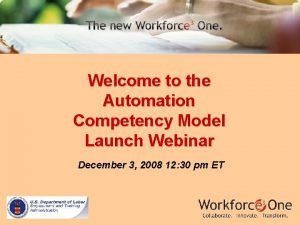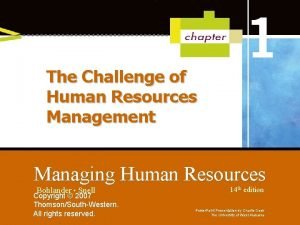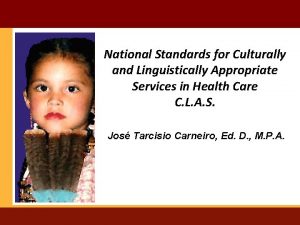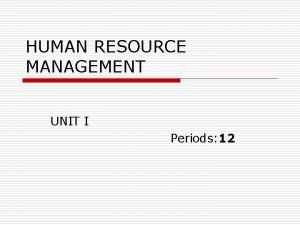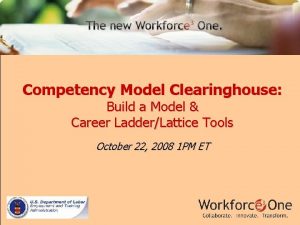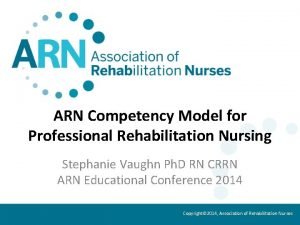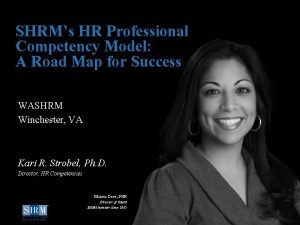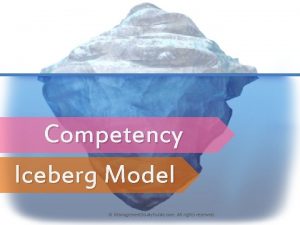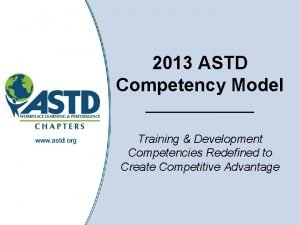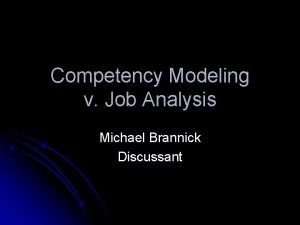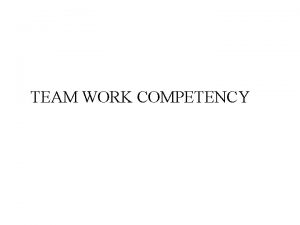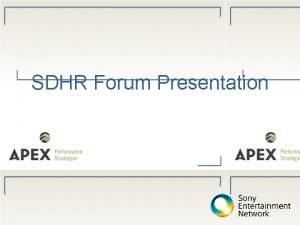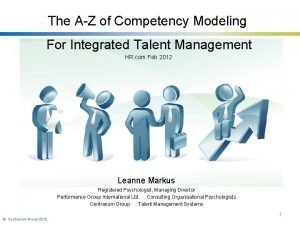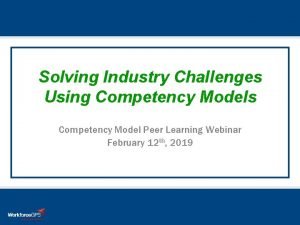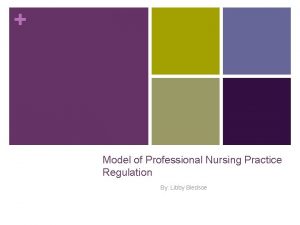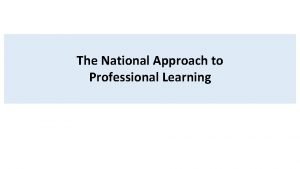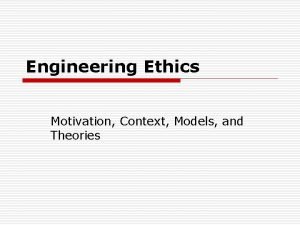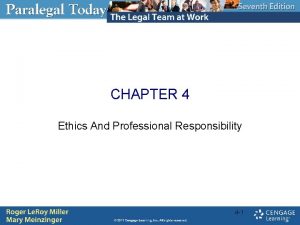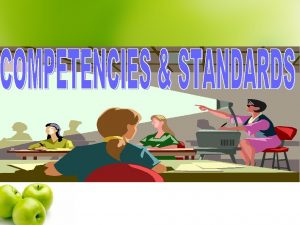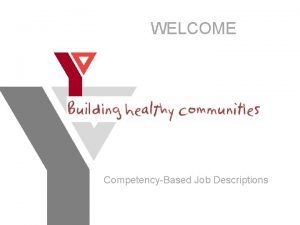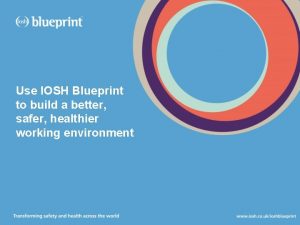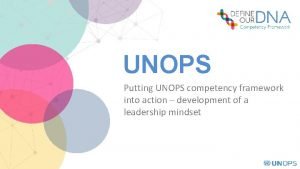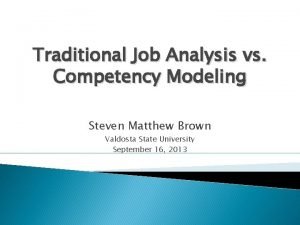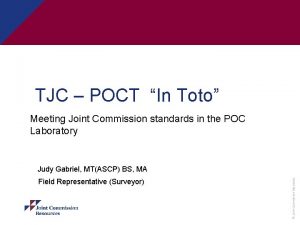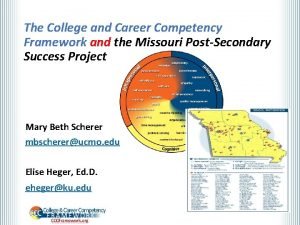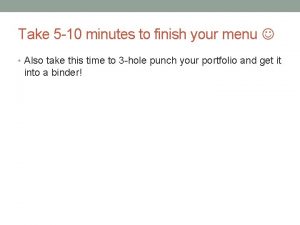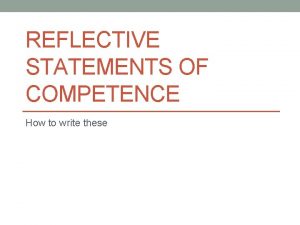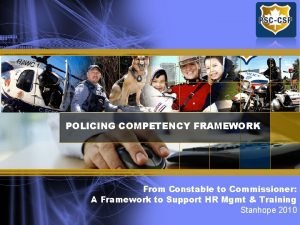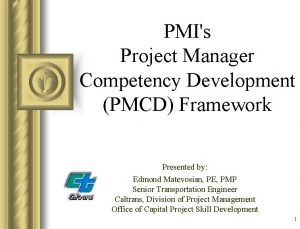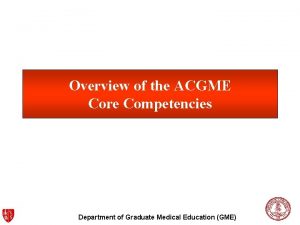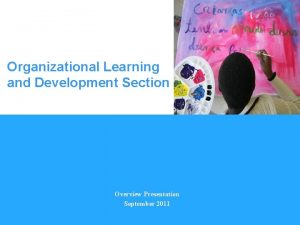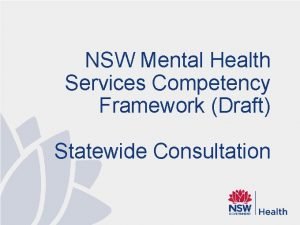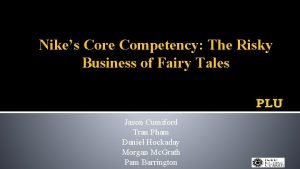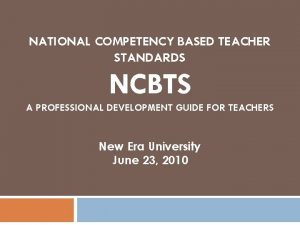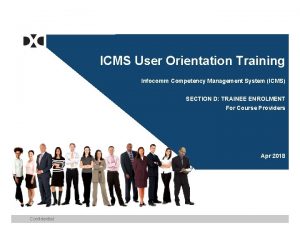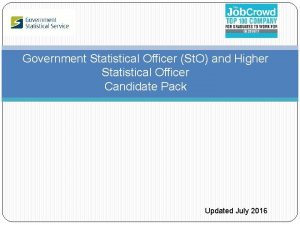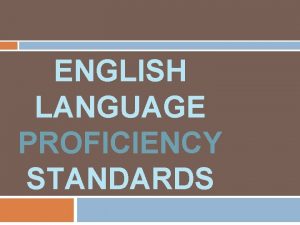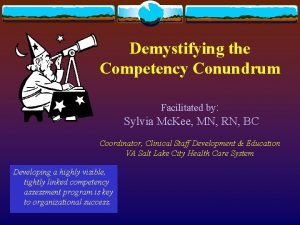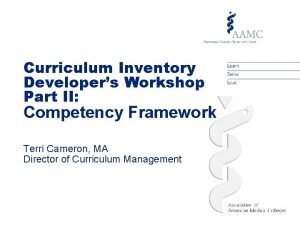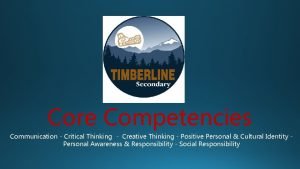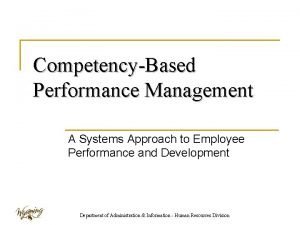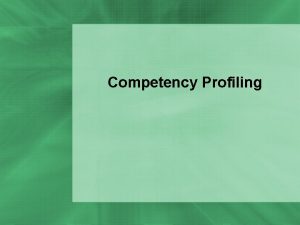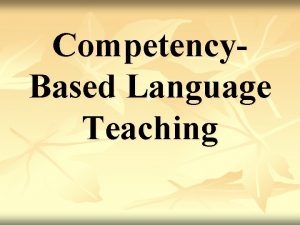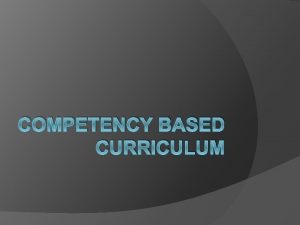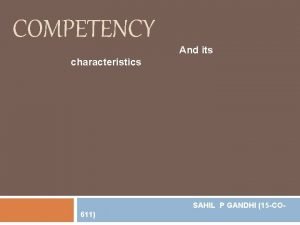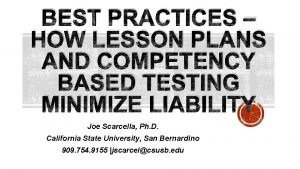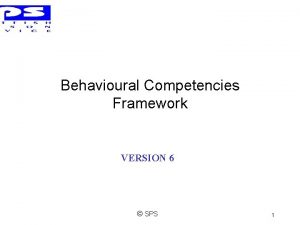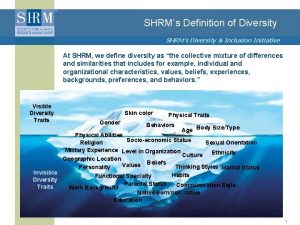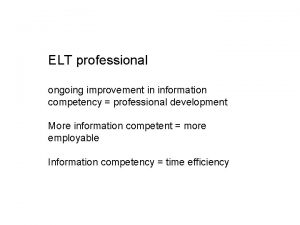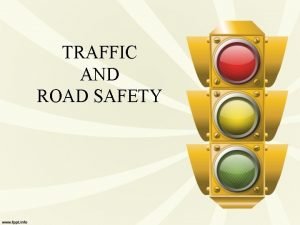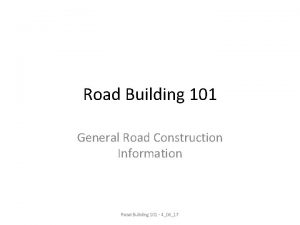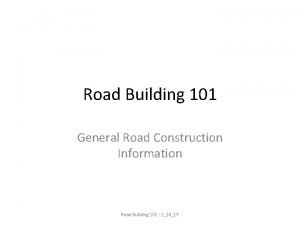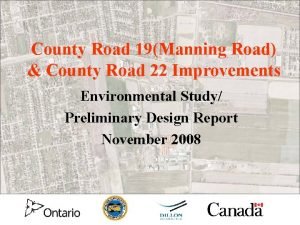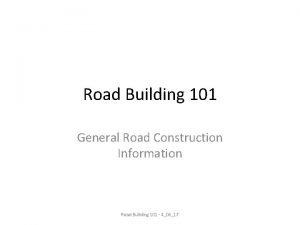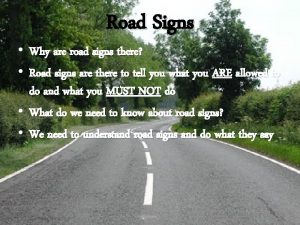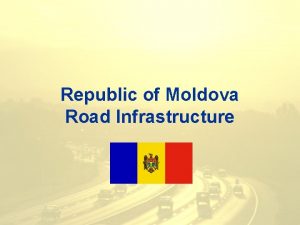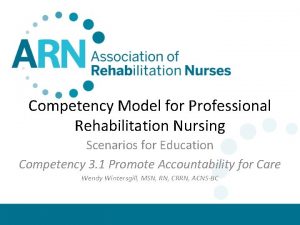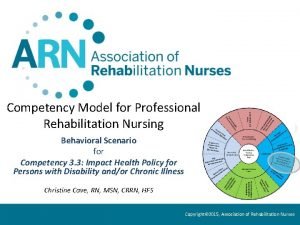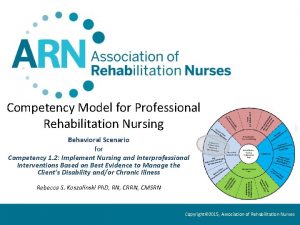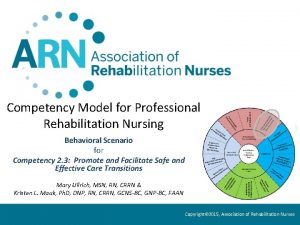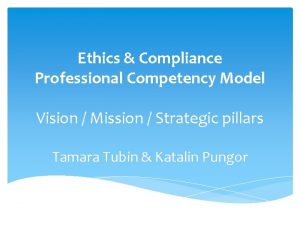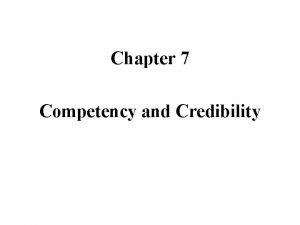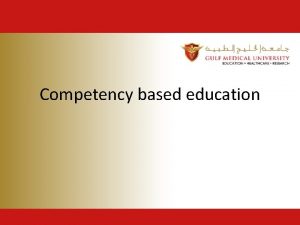1 SHRMs HR Professional Competency Model A Road




















































- Slides: 52

1 SHRM’s HR Professional Competency Model: A Road Map for Success WASHRM Winchester, VAD Kari R. Strobel, Ph. D. Director, HR Competencies Bhavna Dave, PHR Director of Talent SHRM member since 2005 ©SHRM 2014

What Does Success Look Like? ANECDOTES ABOUT THOSE WITH WHOM YOU WORK § Think about someone in the HR profession - with whom you work… § What makes them really good at what they do? – How they do their job – Who they interact with – How they conduct themselves § Take note of what comes to mind § Let’s talk about these “factors” ©SHRM 2014 2

New Expectations for HR 3 “You’ve got to find your extra—your unique value contribution that justifies why you should be hired, why you should be promoted, and why you should be advanced every year. ” --Tom Friedman, Keynote Speaker, 2014 SHRM Annual Conference ©SHRM 2014

Forces for Change A new focus on competencies and behaviors is a great way to advance the HR profession • Highlighting behavioral attributes along with technical skills • Identifying successful performance across career levels • Focus on observable measurable behaviors and proficiency standards New ways of managing talent require new competencies and behaviors from HR New ways of doing business require new ways of managing talent • Globalization • Speed and Flexibility • Government Regulation • Demographic Shifts 4 ©SHRM 2014

What is a Competency? COMPETENCIES DEFINED Competency: A collection of knowledge, skills, abilities, and other characteristics (KSAOs) that are needed for effective performance in the jobs in question (Campion et al. , 2011). ©SHRM 2014 5

The Process 6 DEVELOPMENT AND VALIDATION 2015 2014 2013 2012 • Content Validation • Criterion Validation & Toolkit Refinement • SHRM HR Competency Diagnostic Tools • Competency. Based Certification 2011 • Model Development ©SHRM 2014

Supporting Research 7 DEVELOPMENT DEEP DIVE Model Development § Literature Review – 35 different competency models § Development – 111 Focus Groups o 29 cities globally; 1200 HR Pros § Survey of 640 CHROs Content Validation § 2012 Competency Validation Survey – 32, 000 HR Professionals globally at all career levels § 33 Nations represented in total ©SHRM 2014

How Much of HR is HR? 8 TECHNICAL EXPERTISE § When you think of HR you think of technical areas of expertise or technical competencies including: – – – Talent Acquisition Employee Engagement Learning and Development Total Rewards Labor Relations Employment Law Foundational HR = Technical Expertise § Larger companies have specialists who handle these areas and smaller companies have generalists who handle a variety of HR activities ©SHRM 2014 8

How Much of HR is HR? 9 BEHAVIORAL (NON-TECHNICAL) COMPETENCIES § When you think of HR you should also think of behavioral and leadership competencies: – – – – Ethical Practice Communication Consultation Critical Evaluation Diversity & Inclusion Relationship Management Leadership & Navigation Business Acumen To be successful in HR and grow your career you need more than HR Technical Knowledge § Regardless of the size organization you are in – you need all of these skills, developed over time, to be successful in HR ©SHRM 2014 9

Knowledge + Behavior = Success Behavioral Competencies (Direction) How You Perform Your Job Technical Competencies (Power) What’s Being Performed To be successful in HR and grow your career you need more than just technical competencies Technical Competencies 10 Behavioral Competencies HR Success ©SHRM 2014

SHRM Competency Model HR COMPETENCY MODEL ©SHRM 2014 11

SHRM HR Competency Model Cont. 12 ©SHRM 2014

Technical Competency 13 COMPETENCY DOMAIN #1: HR EXPERTISE § Definition: Knowledge of principles, practices, and functions of effective human resource management § HR Expertise describes the technical expertise needed by HR professionals to design, enact, evaluate, and maintain sound HRM practices § Includes the policies, practices, laws/regulations, and principles that underlie effective HRM E. g. , Talent Acquisition, Employee Engagement, Learning & Development, Total Rewards, Risk Management, & Labor Relations ©SHRM 2014

HR Expertise 14 BEHAVIORS AT HIGHEST LEVEL OF PROFICIENCY § Remains current on relevant laws, legal rulings, and regulations § Maintains up-to-date knowledge of general HR practices, strategy, and technology § Demonstrates a working knowledge of critical human resource functions including: – – – – Strategic Business Management; Workforce Planning and Employment; Human Resource Development; Compensation and Benefits; Risk Management (including safety, environmental health, quality, security, etc. ) Employee and Labor Relations; HR Technology; and Global and International HR. § Delivers customized human resource solutions for organizational challenges § Utilizes core business and HR-specific technologies to solve business challenges ©SHRM 2014

Behavioral Competencies 15 COMPETENCY DOMAIN #2: ETHICAL PRACTICE § Definition: Integration of integrity and accountability throughout all organizational and business practices § Adherence to organizations core values and ethical guidelines § Help to drive your organization’s ethical climate by responding to ethical issues E. g. , Conducting thorough and confidential investigations into reports of unethical behavior and recommending further action E. g. , Developing policies and procedures for employees to report unethical behavior ©SHRM 2014

Ethical Practice 16 BEHAVIORS AT HIGHEST LEVEL OF PROFICIENCY § Maintains confidentiality § Responds immediately to all reports of unethical behavior or conflicts of interest § Empowers all employees to report unethical behavior or conflicts of interest without fear of reprisal § Acknowledges mistakes § Drives the corporate ethical environment § Recognizes personal bias and others’ tendency toward bias, and takes measures to mitigate the influence of bias in business decisions § Maintains appropriate levels of transparency in organizational practices § Ensures that all stakeholder voices are heard § Manages political and social pressures when making decisions ©SHRM 2014

Behavioral Competencies: Strategic Partner Cluster 17 COMPETENCY DOMAIN #3: BUSINESS ACUMEN § Definition: Ability to understand apply information with which to contribute to the organization’s strategic plan § Think in terms of the business and operations first and then apply the HR lens to their work § Systems thinking and economic awareness based upon four areas of knowledge: business administration, finance, marketing, and operations expertise Most proficient HR Practitioner are able to draw a link between HR metrics and business outcomes like key performance indicators ©SHRM 2014

Business Acumen 18 BEHAVIORS AT HIGHEST LEVEL OF PROFICIENCY § Demonstrates an understanding of the strategic relationship between effective human resource management and core business functions § Demonstrates a capacity for understanding the business operations and functions within the organization § Understands the industry and business/competitive environment within which the organization operates § Makes the business case for HR management (e. g. , Return On Investment/ROI) as it relates to efficient and effective organizational functioning § Understands organizational metrics and their correlation to business success § Uses organizational metrics to make decisions § Leverages technology to solve business problems ©SHRM 2014

Behavioral Competencies: Strategic Partner Cluster 19 COMPETENCY DOMAIN #4: CRITICAL EVALUATION § Definition: Interpret information with which to make business decisions and recommendations § HR is all about numbers, metrics, stats, and research! § Mastery of measurement and assessment, critical thinking, and research design with the expressed aim of answering workforce and business questions Evaluate the data, analyze it from different perspectives until you have a good grasp of the details ©SHRM 2014

Critical Evaluation 20 BEHAVIORS AT HIGHEST LEVEL OF PROFICIENCY § Applies critical thinking to information received from organizational stakeholders and evaluates what can be used for organizational success § Gathers critical information § Analyzes data with a keen sense for what is useful § Analyzes information to identify evidence-based best practices § Identifies leading indicators of outcomes § Analyzes large quantities of information from research and practice ©SHRM 2014

Behavioral Competencies: Strategic Partner Cluster 21 COMPETENCY DOMAIN #5: CONSULTATION § Definition: Providing direct guidance to organizational stakeholders § Unique set of attributes to translate complicated information about HRM practices into actionable recommendations 1. Technical Skills: HR Expertise 2. Consulting Skills: Entry and contracting, discovery and dialogue, feedback and decision to act, engagement and implementation, and extension, recycle, or termination 3. Interpersonal Skills: Building Relationships, listening, effectively communicating ©SHRM 2014

Consultation 22 BEHAVIORS AT HIGHEST LEVEL OF PROFICIENCY § Serves as an in-house workforce and people management expert § Analyzes specific business challenges involving the workforce and offers solutions based upon best practice or research § Generates specific organizational interventions (e. g. , culture change, change management, restructuring, training, etc. ) to support organizational objectives § Developing consultative and coaching skills § Guides employees regarding specific career situations ©SHRM 2014

Behavioral Competencies: Interpersonal Cluster 23 COMPETENCY DOMAIN #6 RELATIONSHIP MANAGEMENT § Definition: Developing and managing interactions to provide service and to support the organization § Job success for an HR professional is largely a function of his or her ability to maintain productive interpersonal relationships § Increased performance, team cohesion, and engagement Negotiating both information/task conflict and relationship conflict ©SHRM 2014

Relationship Management BEHAVIORS AT HIGHEST LEVEL OF PROFICIENCY § Establishes credibility in all interactions § Builds engaging relationships with all organizational stakeholders through trust, teamwork, and direct communication § Provides customer service to organizational stakeholders § Promotes successful relationships with stakeholders § Manages internal and external relationships in ways that promote the best interests of all parties § Champions the view that organizational effectiveness benefits all stakeholders § Serves as an advocate when appropriate § Fosters effective teambuilding among stakeholders ©SHRM 2014 24

Behavioral Competencies: Interpersonal Cluster 25 COMPETENCY DOMAIN #7: COMMUNICATION § Definition: Ability to Effectively exchange information with stakeholders § Effective communication is one of the building blocks of personal and career success § When HR information is communicated well, employees better understand the purpose and value of policies and practices HRM viewed to be more effective Positive impact on EE satisfaction and business unit performance ©SHRM 2014

Communication 26 BEHAVIORS AT HIGHEST LEVEL OF PROFICIENCY § Provides clear, concise information to others in verbal, written, electronic, and other communication formats for public and organizational consumption § Listens actively and empathetically to the views of others § Delivers critical information to all stakeholders § Seeks further information to clarify ambiguity § Provides constructive feedback effectively § Ensure effective communication throughout the organization § Provides thoughtful feedback in appropriate situations § Provides proactive communications § Demonstrates an understanding of the audience’s perspective § Treats constructive feedback as a developmental opportunity § Welcomes the opportunity to discuss competing points of view § Helps others consider new perspectives § Helps managers communicate not just on HR issues § Utilizes communication technology and social media ©SHRM 2014

Behavioral Competencies: Interpersonal Cluster 27 COMPETENCY #8: LEADERSHIP & NAVIGATION § Definition: Ability to direct and contribute to initiatives and processes within the organization § HR professionals at each career level can demonstrate Leadership and Navigation. – Foster collaboration with coworkers – Develop strategies to implement HR initiatives – Establish a vision for HR initiatives Employ a results-oriented approach based upon SMART goals to manage resources, projects and products Navigating potential obstacles with extreme political savvy ©SHRM 2014

Leadership & Navigation 28 BEHAVIORS AT HIGHEST LEVEL OF PROFICIENCY § Fosters collaboration § Understands the most effective and efficient way to accomplish tasks within the parameters of organizational hierarchy, processes, systems, and policies § Develops solutions to overcome potential obstacles to successful implementation of initiatives § Demonstrates agility and expertise when leading organizational initiatives or when supporting the initiatives of others § Sets the vision for HR initiatives and builds buy-in from internal and external stakeholders § Leads the organization through adversity with resilience and tenacity § Promotes consensus among organizational stakeholders (e. g. , employees, business unit leaders, informal leaders) when proposing new initiatives § Serves as a transformational leader for the organization by leading change ©SHRM 2014

Behavioral Competencies: Interpersonal Cluster 29 COMPETENCY DOMAIN #9: GLOBAL & CULTURAL EFFECTIVENESS § Definition: The ability to value and consider the perspectives and backgrounds of all parties § Ability to effectively and respectfully interact with colleagues, customers, and clients of varying backgrounds and cultures § Compliance with inclusive hiring practices 67% of U. S. organizations and 74% of Fortune 500 companies utilize diversity training programs ©SHRM 2014

Global & Cultural Effectiveness 30 BEHAVIORS AT HIGHEST LEVEL OF PROFICIENCY § Maintains openness to others’ ideas and makes decisions based upon experience, data, facts and reasoned judgment § Demonstrates nonjudgmental respect for other perspectives § Works effectively with diverse cultures and populations § Appreciates the commonalities, values, and individual uniqueness of all human beings § Embraces inclusion § Navigates the differences between commonly-accepted practice and law when conducting business in other nations § Operates with a global, open mindset while being sensitive to local cultural issues and needs § Takes the responsibility to teach others about the differences and benefits that multiple cultures bring to the organization to ensure inclusion § Incorporates global business and economic trends into business decisions ©SHRM 2014

Closer Look: Levels of Experience 31 Career Level/Years Executive 15 or more Senior 8 -14 Mid 3 -7 Entry 0 -2 • Typically is the most experienced person in HR • Holds the top HR job in the organization or VP role. • Very experienced generalist or specialist • Holds a formal title such as but not limited to, director or principal. • Generalist or experienced specialist • Manages projects or programs • Titles include, but not limited to, HR manager, generalist, or specialists • Specialist in a specific support function • Titles include, but not limited, to HR assistant, junior recruiter, or benefits clerk ©SHRM 2014

Shifting Standards Competency: Business Acumen Creates an action plan for managing talent within the confines of the labor market Executive Implements strategy for managing talent across business lines as well as competitive market Senior Gathers, assembles, and reports HR metrics and labor market trends Mid Early The ability to understand apply information to contribute to the organization’s strategic plan Defines strategy for managing talent within the confines of the labor market and the business model Proficiency standards by career level 32 ©SHRM 2014

Competency Importance Ratings: Overall 33 All but Global and Cultural Effectiveness were rated as IMPORTANT by more than 32, 000 HR professionals; when looking specifically at MNCs, Global and Cultural Effectiveness jumps to over 2 out of 3 – the threshold for importance. HR Expertise Relationship Consultation Leadership Comm Management & Navigation Global & Cultural Eff Ethical Practice Business Acumen Critical Evaluation ©SHRM 2014

Competency Required Upon Entry to HR: Overall 34 Using 65% as a cutoff (standard in Organizational Psychology) we see that all but Global and Cultural Effectiveness is REQUIRED upon entry to the field. Looking just at MNCs, the Global competency would also be included. HR Expertise Relationship Consultation Leadership Management & Navigation Comm Global & Cultural Eff Ethical Practice Business Acumen Critical Evaluation ©SHRM 2014

Competency Importance by Organization Size 35 Looking at 5 breakdowns by size we see virtually no difference in Importance as a function of organizational size. 2 1 0 HR Expertise Relationship Consultation Leadership Comm Management & Navigation Global & Cultural Eff Ethical Practice Business Acumen ©SHRM 2014 Critical Evaluation

Competency Importance by Sector 36 Looking at breakdowns by sector again we see virtually no difference in Importance as a function of organizational sector. 3 2 1 0 HR Expertise Relationship Consultation Leadership Comm Management & Navigation Global & Cultural Eff Ethical Practice Business Acumen ©SHRM 2014 Critical Evaluation

Different Levels, Different Responsibilities, Different Needs 37 Develops HR strategy; Peer group are the other executives in the organization Operationalizes HR strategy; Translates strategy into a plan Implements plan and contributes to the refinement of the plan Carries out the plan at the transactional level ©SHRM 2014

Career Level Differences COMPETENCY IMPORTANCE VARIES BY CAREER LEVEL § Which competencies – do you think - are more important than others at the different career levels? – Early? – Mid? – Senior? – Executive? ©SHRM 2014 38

Entry Level 39 CAREER LEVEL DIFFERENCES 2. 46 Ethical Practice 2. 11 Communication 2. 09 Relationship Management 1. 75 HR Expertise 1. 59 1. 53 1. 50 1. 48 Business Acumen Critical Evaluation Consultation Global & Cultural Effectiveness Leadership and Navigation 1. 29 ©SHRM 2014

Mid Level 40 CAREER LEVEL DIFFERENCES Mid 2. 64 Ethical Practice 2. 34 Relationship Management 2. 33 Communication 2. 24 HR Expertise 2. 07 Consultation 1. 88 1. 84 1. 73 1. 69 Business Acumen Critical Evaluation Leadership & Navigation Global & Cultural Effectiveness ©SHRM 2014

Senior Level 41 CAREER LEVEL DIFFERENCES Senior 2. 77 Ethical Practice 2. 65 HR Expertise 2. 55 Relationship Management 2. 51 Communication 2. 44 Consultation 2. 34 Leadership & Navigation 2. 24 Business Acumen Critical Evaluation 2. 21 Global & Cultural Effectiveness 1. 97 ©SHRM 2014

Executive 42 CAREER LEVEL DIFFERENCES Executive 2. 87 Ethical Practice 2. 79 HR Expertise 2. 7 Relationship Management 2. 64 Communication 2. 63 Consultation 2. 57 Leadership & Navigation 2. 5 Business Acumen 2. 42 Critical Evaluation 2. 13 Global & Cultural Effectiveness ©SHRM 2014

Competency-based Services SHRM HR Diagnostic Tools • • SHRM Effectiveness SHRM Self SHRM 180 SHRM 360 SHRM Certification • SHRM-SCP • SHRM-CP Behavioral Interview Guide • Questions • Anchored Responses • Scoring Reference Book Career Paths and Seminars 43 ©SHRM 2014

SHRM Body of Competency & Knowledge shrmcertification. org 44 ©SHRM 2014 44

Eligibility Requirements 45 The SHRM certification program recognizes the value of formal HR education, makes certification accessible to professionals with less-than-full-time work arrangements, and provides a pathway from SHRM-CP to SHRM-SCP. shrmcertification. org ©SHRM 2014

For Existing Certificants 46 From January 5, 2015, to 31 December 2015, holders of a valid HR generalist certification can be eligible to obtain the SHRM-CP or SHRM-SCP. Credential holders will complete a simple three-step process: 1. Agree to abide by the SHRM Code of Ethics; 2. Affirm that you hold a valid HR credential; and 3. Complete the online tutorial on HR competencies. Holders of credentials like PHR & HRBP* will be eligible for: Holders of senior-level credentials like SPHR, GPHR, & HRMP* will be eligible for: You are not required to give up your existing credentials. Credentials must be earned by January 31, 2015, in order to be eligible for the three-step pathway process. ©SHRM 2014 trademarks of the *Note: PHR, SPHR, GPHR, HRBP and HRMP are registered HR Certification Institute and are not SHRM certifications.

For Aspiring Certificants 47 Individuals interested in pursuing certification this year should continue preparations and take an HR general certification exam (e. g. PHR/SPHR/GPHR exam) prior to January 31, 2015. o If you pass the exam, you will be eligible to receive the new SHRM certification by completing the simple three-step process. o If you purchased the 2014 SHRM Learning System last year, and took the exam it supports, but did not pass, you will be eligible to receive the new version of the SHRM Learning System that supports the SHRM-SCP or SHRM-CP at no cost following registration for the May-July 2015 SHRM-CP or SHRM-SCP testing window. o If you purchased the 2014 SHRM Learning System last year, and decided not to take your exam, you will be eligible to receive the new version of the SHRM Learning System at no cost following registration for the May-July 2015 SHRMCP or SHRM-SCP testing window. shrmcertification. org ©SHRM 2014

Key Dates Oct 2014 48 Pilot testing of SHRM-CP and SHRM-SCP exams Nov 2014 Instructor Materials for SHRM-CP and SHRM-SCP become available Dec 2014 SHRM Learning System for SHRM-CP and SHRM-SCP becomes available Jan 2015 Registration begins for first SHRM-CP and SHRM-SCP exam window Jan 2015 Holders of existing HR generalist certifications can complete the 3 -step pathway process to obtain their SHRM-CP or SHRM-SCP (5 Jan thru 31 Dec 2015) May 2015 Initial exam window opens for SHRM-CP and SHRM-SCP ©SHRM 2014

Recertification Credits Category Description/Examples 49 Maximum Number of Professional Development Credits (PDCs) Advance Your Education Continuing education such as: o. Conferences o. College courses o. Seminars oe-Learning (Instructor-Led and Self-Directed) o. Chapter programs o. Webcasts o. Audiocasts o. Podcasts Advance Your Organization Work projects endorsed by supervisor which support organizational goals and advance or demonstrate capabilities in one or more HR competency. o Maximum of 20 PDCs per cycle Advance Your Profession Thought leadership and volunteer activities such as: o. Professional membership o. Volunteer leadership o. Speaking at conferences o. Writing and Research o Maximum of 30 PDCs per cycle o No maximum for instructor-led PDCs o Maximum of 30 PDCs for selfdirected programs ©SHRM 2014

50 ©SHRM 2014 Image courtesy of Stuart Miles/Free. Digital. Photos. net 50

51 Kari R. Strobel, Ph. D. kari. strobel@shrm. org 703 -535 -6328 (W) @SHRMResearch www. shrm. org ©SHRM 2014 51

52 (Please note that these slides are copyrighted material and may only be distributed to an audience at a SHRM speaker presentation. Further distribution is not allowed, except with permission by SHRM. ) ©SHRM 2014
 Paved road vs unpaved road
Paved road vs unpaved road Automation competency model
Automation competency model Hr mastery
Hr mastery During this step of the cultural competency staircase model
During this step of the cultural competency staircase model Competency model in hrm
Competency model in hrm Competency model clearinghouse
Competency model clearinghouse Arn competency model
Arn competency model Shrm competency model
Shrm competency model Competency iceberg model
Competency iceberg model Astd model
Astd model Competency modeling vs job analysis
Competency modeling vs job analysis Boyatzis competency model
Boyatzis competency model Lominger competency model
Lominger competency model Heb competency model
Heb competency model What is a competency
What is a competency Model of professional nursing practice regulation
Model of professional nursing practice regulation National approach to professional learning
National approach to professional learning Minimalist model of professional ethics
Minimalist model of professional ethics Nala's paralegal canons of ethics
Nala's paralegal canons of ethics Model of professional thinking
Model of professional thinking Ncees model rules of professional conduct
Ncees model rules of professional conduct What are competencies
What are competencies Competency based job description sample
Competency based job description sample Iosh blueprint
Iosh blueprint Unops competency framework
Unops competency framework Traditional job analysis vs competency approach
Traditional job analysis vs competency approach Accu-chek inform ii competency test answers
Accu-chek inform ii competency test answers Career competency framework
Career competency framework Competency statement 2 for cda
Competency statement 2 for cda Reflective statement of competence
Reflective statement of competence Competency framework police
Competency framework police Project manager competency development
Project manager competency development Acgme core competency
Acgme core competency Unicef competency framework
Unicef competency framework Camhs competency framework
Camhs competency framework Core competencies meaning
Core competencies meaning 7 domains of ncbts
7 domains of ncbts Budaya organisasi adalah
Budaya organisasi adalah Infocomm competency management system
Infocomm competency management system Higher statistical officer
Higher statistical officer Language proficiency levels
Language proficiency levels Higher executive officer civil service
Higher executive officer civil service Competence vs competency
Competence vs competency Physician competency reference set
Physician competency reference set Stuntnastics
Stuntnastics Competency based performance management system
Competency based performance management system Competency profiling
Competency profiling Integration competency center
Integration competency center Cblt adalah
Cblt adalah Similarities between 8-4-4 and cbc
Similarities between 8-4-4 and cbc Sahil n gandhi
Sahil n gandhi Competency based language teaching lesson plan
Competency based language teaching lesson plan Sps behavioural competency framework
Sps behavioural competency framework

